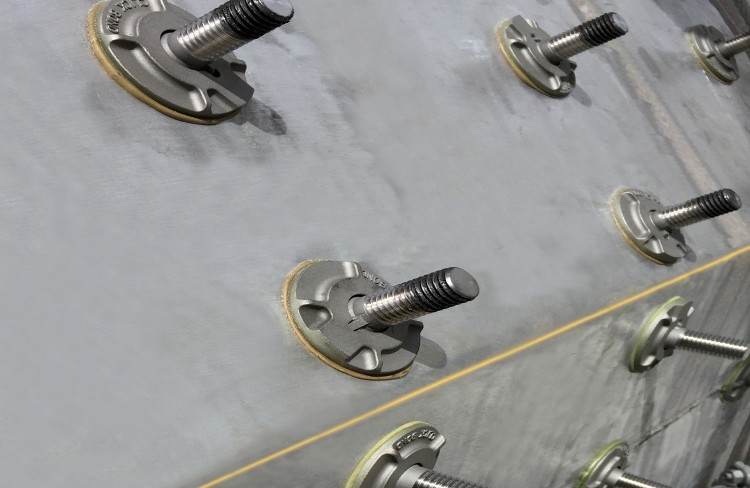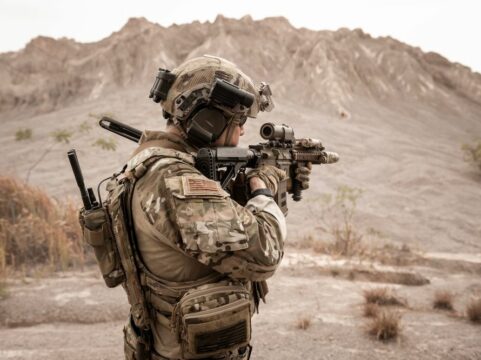Marine Bonded Fasteners: Their Comprehensive Applications

- June 20th, 2024
- Categories: Uncategorised
Navy military ships are constantly exposed to water in the marine industry, and marine-grade metals are excellent for underwater or damp environments. In these environments, marine bonded fasteners actively fight against corrosion, mechanical failure, water force, and abrasion.
In comparison to traditional fasteners, marine-bonded fasteners are reliable and durable , components that improve vessel performance, which is critical in high-risk, heavy-duty industries.
From supporting surface ships to submarines, this blog will explore why and how these fasteners target common challenges at sea and how naval engineers can apply them.
Advantages of Marine Bonded Fasteners

Marine-bonding fasteners are the smart choice for marine vessels that need to fight against galvanic corrosion, but what are the best materials, and why should you use them? With any naval application, marine-grade fastening solutions are paramount to safety at sea.
Compared to fresh water, vessels are less affected. Being less corrosive with lower levels of conductivity and penetrating power of chlorine, there is less time needed for maintenance sessions, and there isn’t much of a need to consider your fastening materials.
As for saltwater, this can damage many areas of your boat, including metal fixtures, rubber fittings, and screws, and can speed up wear and tear. Saltwater is highly corrosive and can lead to accelerated degradation of metal fasteners. This is where marine-bonded fasteners come into the picture.
1. Powerful materials
Composite materials such as stainless steel, particularly Grade 316, can resist pitting and saltwater corrosion. Grade 302 stainless steel mechanical fasteners are also suitable for high temperatures.
Marine-grade alloy steel, which has the strength of regular alloy steel and corrosion resistance for shipbuilding. MD, ME, MF and MG grades, appropriate for offshore structural applications.
Brass, or naval brass, is often used in military applications, blended with zinc and tin for manoeuvring and stronger joints at sea.
Bronze, silicone, or aluminium bronze have military uses, fending of mussels, algae, and produces minimal friction in propeller shafts.
Marine-grade carbon steel for naval applications includes AH36, EH36, or DH36.
Non-metallic materials such as high-performance ceramics and polymers can also be used in marine applications, both on and off-shore.
2. Withstands environmental conditions
Unlike land, sea conditions require composite fasteners that can handle ever-changing weather. The waters of north Australia, for example, are calmer but can be unpredictable environmental factors. This includes everything from cyclonic winds to heavy rain, and high seas. Surface temperatures in the middle of summer can even reach up to 80 degrees Celsius on a ship’s surface.
Marine vessels operate in a wide range of conditions, from icy polar waters to tropical climates. Temperature fluctuations can cause materials to expand, resulting in loosening over time, so fasteners need to withstand extreme levels of thermal stress.
Exposure to sunlight and UV rays can degrade materials such as plastics and coatings. Speciality fasteners include UV-resistant coatings, so you don’t need to worry about compromising fastener integrity or premature failure.
Seawater is a complex solution of different salts and minerals, so chemical exposure is always risky. Speciality marine-bonded fasteners can stop chemical reactions and fastener weakening over time.
3. Vibration and shock-resistant
Intense, relentless vibrations and shock forces encountered during missions at-sea are capable of loosening fasteners over time.
Click Bond’s Swivel Gimbal Thread prevents this under high vibration.
4. Higher mechanical strength and load distribution
Marine environments pose risks due to saline conditions, dynamic wind forces, wave impacts, operational strains, and extreme pressures from water depth. This is why there is always a demand for trustworthy naval equipment.
Tensile loads must be distributed correctly to prevent structural failure. If fasteners loosen or deform–such as pull on fasteners in opposite directions–or fluctuate with repeated stress over time.
For these reasons, marine-bonded fasteners increase fastener performance for naval structures. Specialised fasteners such as bolts, nuts (made from high-tensile steel), and nickel-based superalloys are employed. In some cases, welding or adhesive bonding used with mechanical fasteners may be necessary.
5. Bonding, sealing, and dampening
You can save time, weight, cost, and design freedom with chemical bonding, sealing, and dampening products. Sealants and adhesives help to join, waterproof, dampen sounds, insulate, and prevent galvanised corrosion in marine environments.
Rigid adhesives such as Click Bonds CB420-50E have a high mechanical strength, accommodating production rates and structural component assembly. This cured bond absorbs strong forces and shock, making naval structures durable and reliable at sea.
6. Flexible bonding and sealing
Distinct from bonding and high modulus adhesives, this method is applied in a bond line thickness of some millimetres.
Although this method doesn’t have the high mechanical stretch of rigid bonding, it has greater flexibility and cutting back fatigue in the bonded components.
7. Flooring and acoustic dampening
As sub-decks are not always smooth and level, these are responsible for the transmission of most of the noise in cabins and compartments.
Modern flooring improves the marine environment due to a level and smooth deck, a reduced transmission of noise levels, the cosmetic finish improves the appearance, and various systems can be put in place to amplify these.
Types of Marine Bonded Fasteners

Designing and manufacturing adhesive-bonded fasteners that are durable and labour-saving when working with a structure, ClickBond is a product leader in fasteners for naval ships. With this in mind, what variations of their fasteners can you consider for your upcoming project?
> Brackets and clamps. A Heavy-Duty Bulkhead Stud protects ships against galvanic corrosion, simplifies repairs at sea, reduces lagging, and is ideal for late-stage outfitting.
> Fuel and fluid tanks. The Two-Lug Sealed Nutplate is for closeout of wet bays or pressure vessels. It simplifies nut plate installation by offering bond line clamp-up and maintenance. It can be applied to decking or floorboards, panels, interiors, structural components, and more.
> Pressurised vessels. The One-Lug Bracket-Retained Nutplate is an epoxy adhesive cartridge that protects threads of adhesive and reduces the footprint for FOD-critical applications. Apply to panels, interiors, fairings, and more.
> Structural components. The High Shock Very Large Base Stud secures deck boards, furnishings, and other shock-proof attachments. This can be applied to systems attachments, interiors, equipment attachments, and more.
> Insulation blankets. The Swivel Cable-Tie Mount has a metallic base and a swivel with the thermoplastic saddle. Supplied with a disposable installation fixture, it can be applied to tubing and hoses, lighting and senses, and more.
Applications of Marine Bonded Fasteners
Now that we know why marine-bonded fasteners are so advantageous let’s look at the multiple ways they can be applied in the field. After all, fastening solutions for marine composites require high strength and design flexibility.
- Carbon fibre composite overlays (patches) were installed on a Royal Australian Navy frigate to prevent superstructure fatigue cracking. Composite repair restores the strength and function of the damaged structure.
- The Royal Australian Navy (RAN) has run a program of structural inspections for their ships–managed by Maritime Engineering (CME)–who maintain data of all defects.
- Warships are high-performance yet will always anticipate cracking over the lifespan of the vessel.
According to this report, a comprehensive trial confirmed that a carbon fibre patch/overlay meets ship repair’s short- and long-term needs. Marine-bonded fasteners are essential to every naval architect.
Marine-bonded fasteners require zero installation holes, eliminating the need for hot work, gas freeing, and welding.
Applied Fasteners and Tooling: Marine Bonded Fasteners
Are you in the market for an adhesive solution, enhanced torque resistance, improved tensile loads, or more advanced materials for surface treatment? Applied Fasteners and Tooling are registered AS9120 quality-certified marketing leaders in the fastening system supply chain.
Whether you need Cable Tie Mounts, Motorsport Fasteners, Countersink Tooling, Hi-Lok Tooling, mechanical fixings or hybrid-bolt adhesive joints, AFT will guide your project to the best adhesive technology.
Contact us today for value-added service in product cycle design, procurement, production, quality, maintenance and repair.






